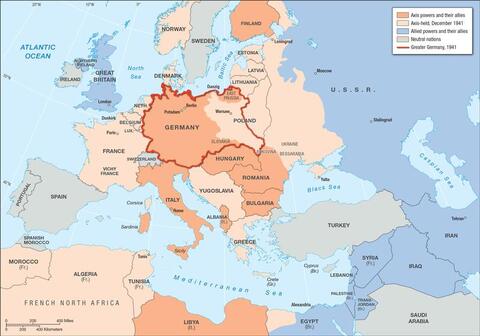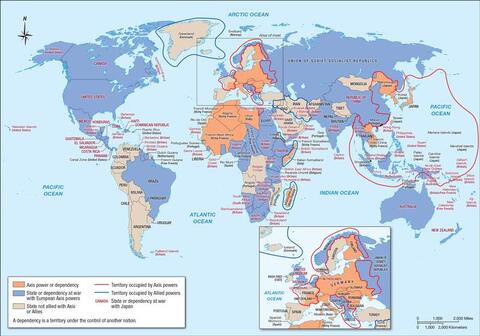Europe in Germany’s Grasp
At a Glance
Language
English — USSubject
- History
- The Holocaust
By December 1941, Germany had conquered most of mainland Europe, from France in the west to the outskirts of Moscow in the Soviet Union in the east. When the United States entered the war after the Japanese attack on Pearl Harbor that month, World War II became a truly global war. On one side were the Axis powers, led by Germany, Japan, and Italy. On the other side were the Allied powers, led by Great Britain (and other members of the United Kingdom), the Soviet Union, and the United States. The maps in this reading show both Europe and the world in December of 1941, when Germany controlled its largest territory.
Germany had expected a “lightning” victory in the Soviet Union, and the Germans believed they would be marching into Moscow, the capital, before the winter of 1941. But in spite of the early success of Operation Barbarossa, German forces were unable to capture Moscow. The Soviets stopped the German eastward advance at the city’s outskirts. Unprepared for the brutal winter they did not expect to have to fight through, German forces began to suffer defeats on the eastern front. Historian Doris Bergen writes that the Nazis fell victim to their own false beliefs:
Hitler expected the campaign against the Soviet Union to be easy for the Germans. In this regard, he and his military planners were caught in their own racial and ethnic stereotypes. They thought of Slavs as stupid and incompetent and believed that the Communist Soviet Union was in the grip of Jews, whom they viewed as cowardly and perfidious. Such attitudes caused the German leaders to make some severe miscalculations.
The German invasion did not turn out as planned. The Soviets were better equipped than German planners had thought; the Germans themselves were overextended and unprepared for winter. 1
As a result, the German conquest of eastern Europe would begin to stall in the Soviet Union in the following year, and the consequences for those the Nazis considered “racial enemies” would grow even more dire.
- 1Doris L. Bergen, War and Genocide: A Concise History of the Holocaust, 3rd ed. (Lanham, MD: Rowman & Littlefield, 2016), 194.
Europe and the Middle East, 1941

Europe and the Middle East, 1941
By the end of 1941, Germany and its allies, the Axis powers, had conquered most of continental Europe, from the eastern border of Spain to the outskirts of Moscow.
World War II, 1941

World War II, 1941
After Japan attacked the United States in December 1941, World War II became truly global with battles between the Axis and the Allies occurring on nearly every continent.
Connection Questions
- Who were Germany's allies? What might have been the benefits of forming an alliance with Germany in World War II? What might have been the dangers?
- Using what you have learned about the Nazi plan for “race and space,” locate on these maps the areas that the Nazis sought for Lebensraum, or “living space.” By December 1941, had they achieved their goals? What threats or challenges to their plans for “race and space” do these maps suggest?
- What advantages do these maps suggest that the Allied powers had in their fight against Germany and the other Axis powers? What challenges stood in the Allies’ way?
How to Cite This Reading
Facing History & Ourselves, "Europe in Germany’s Grasp," last updated August 2, 2016.








